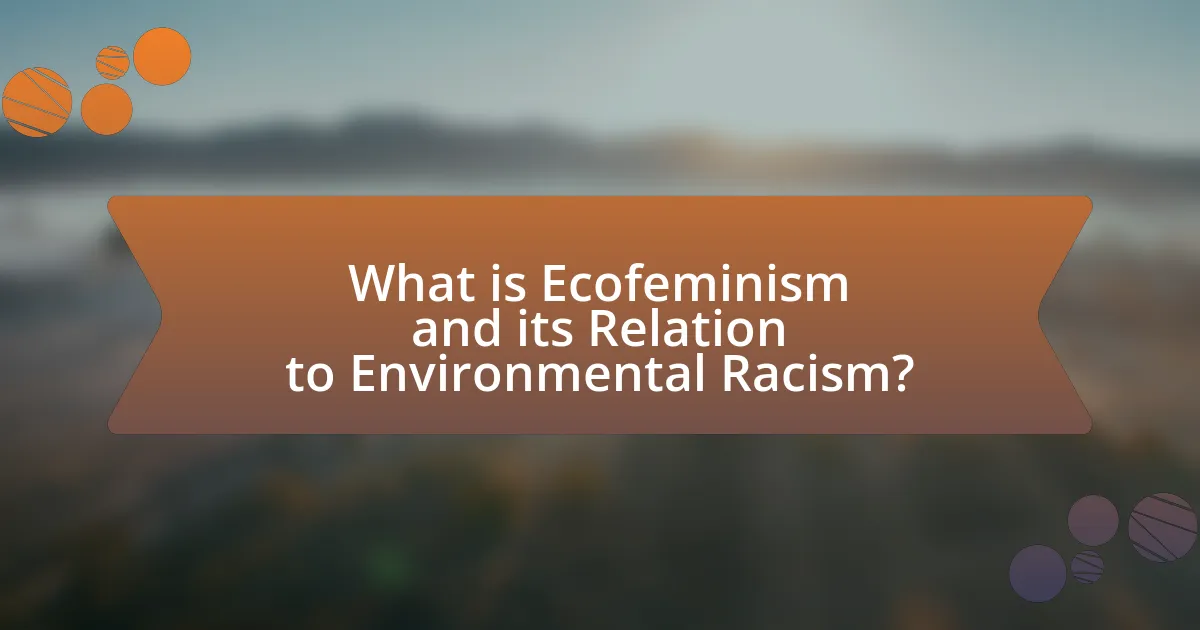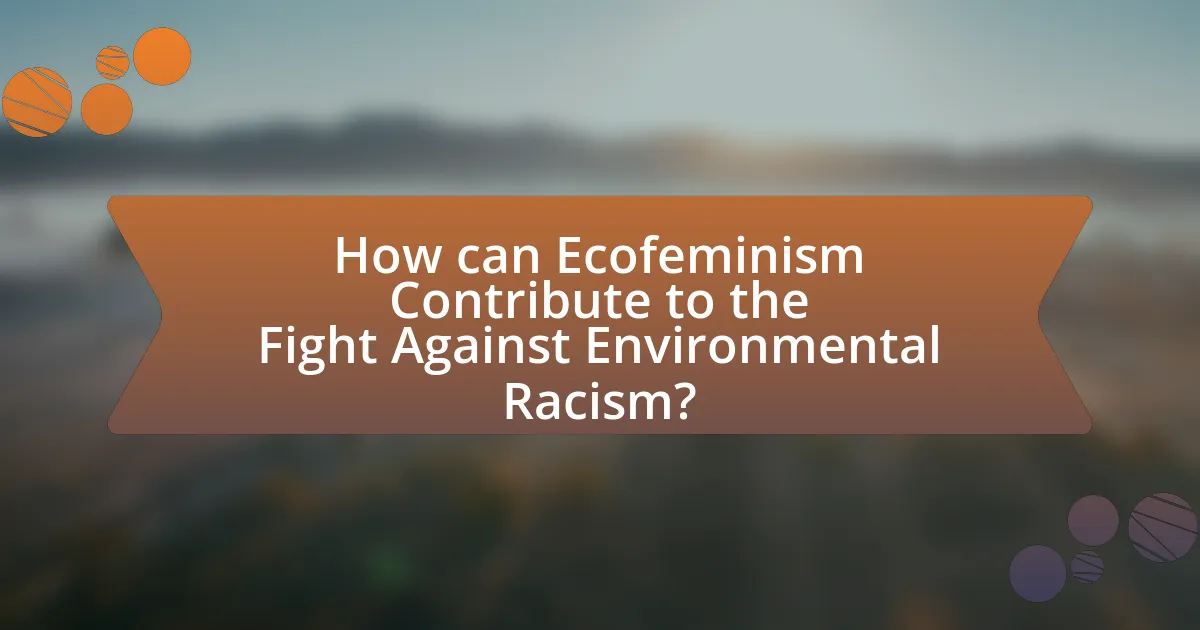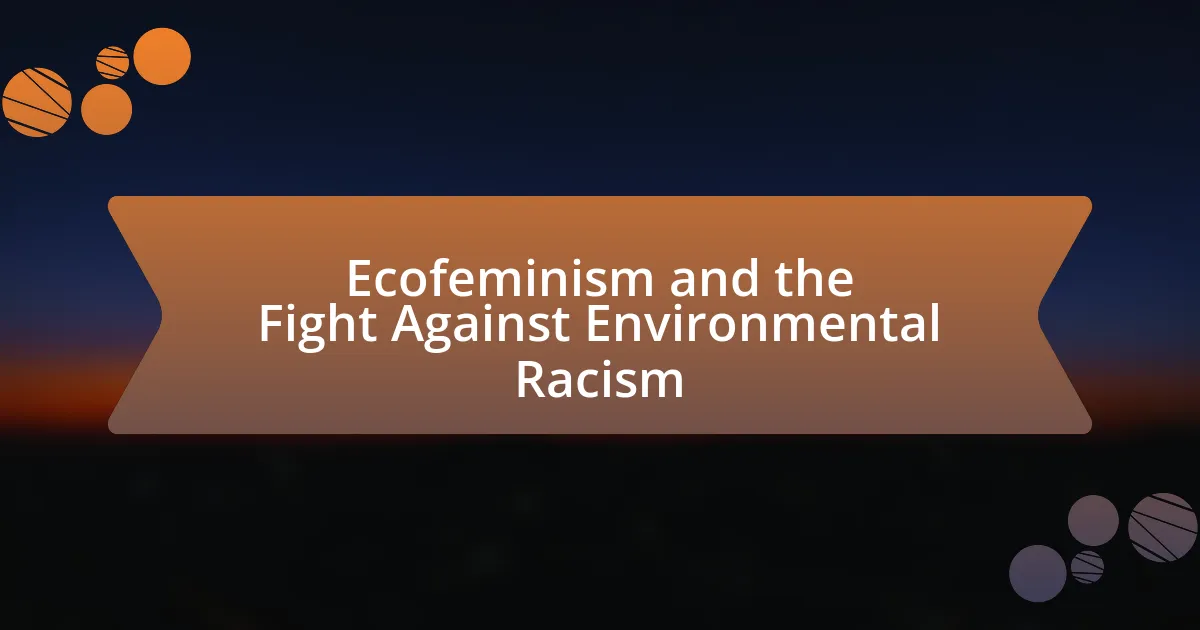Ecofeminism is a philosophical and social movement that examines the interconnectedness of the exploitation of women and nature, emphasizing how both are subjected to patriarchal oppression. The article explores the relationship between ecofeminism and environmental racism, highlighting how marginalized communities, particularly women and people of color, disproportionately suffer from environmental degradation. It critiques traditional environmentalism for neglecting social injustices and advocates for inclusive policies that address both ecological sustainability and gender inequalities. The article also discusses the historical contexts that shaped ecofeminism, its core principles, and the strategies that ecofeminists can employ to combat environmental racism, including grassroots organizing and education. Additionally, it presents successful case studies that illustrate the effectiveness of ecofeminist activism in addressing these critical issues.

What is Ecofeminism and its Relation to Environmental Racism?
Ecofeminism is a philosophical and social movement that connects the exploitation of women and nature, arguing that both are subjected to patriarchal oppression. It posits that environmental degradation disproportionately affects marginalized communities, particularly women and people of color, highlighting the intersection of gender, ecology, and social justice. Environmental racism refers to the systemic placement of hazardous waste sites, pollution, and other environmental burdens in communities of color, exacerbating health disparities and social inequities. Ecofeminism critiques this injustice by emphasizing that the fight for environmental sustainability must include the voices and rights of those most affected, advocating for a holistic approach to both ecological and social issues.
How does Ecofeminism define the intersection of gender and environmental issues?
Ecofeminism defines the intersection of gender and environmental issues by highlighting how the exploitation of women and nature is interconnected. This perspective asserts that both women and the environment face oppression through patriarchal structures that prioritize domination and control over nurturing and sustainability. Ecofeminists argue that environmental degradation often disproportionately affects women, particularly in marginalized communities, as they are typically responsible for resource management and household sustenance. Research indicates that women in developing countries are more vulnerable to the impacts of climate change, as they rely heavily on natural resources for their livelihoods. This connection underscores the need for inclusive environmental policies that address gender inequalities while promoting ecological sustainability.
What historical contexts have shaped Ecofeminism’s emergence?
Ecofeminism emerged from the intersection of environmentalism and feminist movements, shaped by historical contexts such as the rise of the women’s liberation movement in the 1960s and 1970s, which highlighted gender inequalities and the exploitation of women. Additionally, the environmental movement’s growing awareness of ecological degradation during the same period underscored the connection between the oppression of women and the exploitation of nature. The publication of works like “The Death of Nature” by Carolyn Merchant in 1980 further solidified these links by critiquing the patriarchal narratives that contributed to environmental destruction. Furthermore, the impact of colonialism and globalization has illustrated how marginalized communities, particularly women of color, face disproportionate environmental injustices, reinforcing the need for an ecofeminist perspective that addresses both gender and ecological issues.
How does Ecofeminism critique traditional environmentalism?
Ecofeminism critiques traditional environmentalism by highlighting its tendency to overlook the interconnectedness of gender, race, and ecological issues. Traditional environmentalism often prioritizes nature conservation without addressing the social injustices that disproportionately affect marginalized communities, particularly women and people of color. Ecofeminists argue that this narrow focus fails to recognize how environmental degradation is linked to patriarchal structures and systemic inequalities. For instance, they emphasize that women in developing countries are often the primary caregivers and are directly impacted by environmental policies that disregard their needs and voices. This critique is supported by studies showing that environmental policies can exacerbate existing inequalities, as seen in cases where industrial pollution disproportionately affects low-income neighborhoods, which are often inhabited by racial minorities.
Why is understanding environmental racism crucial within Ecofeminism?
Understanding environmental racism is crucial within Ecofeminism because it highlights the intersection of environmental issues and social justice, particularly how marginalized communities, often women and people of color, disproportionately suffer from environmental degradation. This understanding is essential for Ecofeminism as it seeks to address both ecological and gender inequalities, recognizing that environmental harm is not experienced equally across different demographics. For instance, studies show that communities of color are more likely to be located near hazardous waste sites, which exacerbates health disparities and undermines their quality of life. By integrating the concept of environmental racism, Ecofeminism can advocate for equitable environmental policies that protect vulnerable populations and promote sustainability.
What are the key characteristics of environmental racism?
Environmental racism is characterized by the disproportionate impact of environmental hazards on marginalized communities, particularly communities of color. This phenomenon manifests through the placement of hazardous waste sites, polluting industries, and toxic landfills in these neighborhoods, leading to adverse health outcomes and diminished quality of life. For instance, studies have shown that predominantly Black and Latino communities are more likely to live near industrial facilities that emit pollutants, resulting in higher rates of respiratory illnesses and other health issues. Additionally, environmental racism is evident in the lack of political power and representation for these communities, which often leads to inadequate responses to environmental concerns and insufficient access to resources for mitigation and adaptation.
How does environmental racism disproportionately affect marginalized communities?
Environmental racism disproportionately affects marginalized communities by subjecting them to higher levels of pollution and environmental hazards compared to more affluent populations. Studies show that communities of color and low-income neighborhoods are often located near toxic waste sites, landfills, and industrial facilities, leading to increased health risks such as respiratory diseases and cancer. For instance, a report by the United States Environmental Protection Agency indicates that Black and Hispanic populations are more likely to live in areas with higher air pollution levels, which correlates with adverse health outcomes. This systemic inequity is rooted in historical practices of segregation and discriminatory zoning laws that prioritize the interests of wealthier, predominantly white communities over those of marginalized groups.

What are the Core Principles of Ecofeminism?
The core principles of ecofeminism include the interconnectedness of the exploitation of women and nature, the critique of patriarchy, and the advocacy for social justice and environmental sustainability. Ecofeminism posits that both women and the environment are subjected to similar forms of domination and oppression, often rooted in patriarchal structures. This perspective emphasizes that addressing environmental issues requires acknowledging and dismantling gender inequalities, as evidenced by the work of scholars like Vandana Shiva, who highlights the link between ecological degradation and the marginalization of women in developing countries. Additionally, ecofeminism advocates for holistic approaches that integrate ecological health with social equity, reinforcing the idea that true sustainability cannot be achieved without addressing systemic injustices.
How does Ecofeminism advocate for social justice and ecological sustainability?
Ecofeminism advocates for social justice and ecological sustainability by linking the exploitation of nature to the oppression of marginalized groups, particularly women. This perspective emphasizes that environmental degradation disproportionately affects vulnerable communities, highlighting the need for inclusive policies that address both ecological and social issues. For instance, ecofeminists argue that sustainable practices must incorporate social equity, as seen in movements that promote community-led environmental initiatives, which empower local populations and prioritize their needs. Research indicates that areas with strong ecofeminist activism often see improved environmental policies that also enhance social justice outcomes, demonstrating the interconnectedness of these struggles.
What role do women play in environmental activism according to Ecofeminism?
Women play a crucial role in environmental activism according to Ecofeminism by linking the exploitation of nature to the oppression of women. Ecofeminism posits that both women and the environment are marginalized and that their liberation is interconnected. Women often lead grassroots movements, advocating for sustainable practices and environmental justice, as seen in various global initiatives where female activists challenge environmental degradation and promote ecological stewardship. For instance, Wangari Maathai, founder of the Green Belt Movement in Kenya, mobilized women to plant trees and combat deforestation, illustrating the significant impact women have in addressing environmental issues. This connection between gender and environmental activism highlights the importance of women’s voices in the fight against environmental racism and ecological destruction.
How does Ecofeminism challenge patriarchal structures in environmental policies?
Ecofeminism challenges patriarchal structures in environmental policies by highlighting the interconnectedness of gender oppression and environmental degradation. This perspective argues that both women and nature have been historically marginalized and exploited under patriarchal systems, leading to policies that prioritize economic growth over ecological and social justice. For instance, ecofeminists advocate for inclusive decision-making processes that consider the voices of women and marginalized communities, thereby promoting sustainable practices that respect both human rights and environmental integrity. Research by Vandana Shiva emphasizes that empowering women in environmental governance leads to more effective and equitable resource management, demonstrating that ecofeminism not only critiques existing policies but also offers alternative frameworks that dismantle patriarchal dominance in environmental discourse.
What are the critiques of Ecofeminism in addressing environmental racism?
Critiques of Ecofeminism in addressing environmental racism include its tendency to universalize women’s experiences, which can overlook the specific needs and voices of marginalized communities. This approach often fails to adequately address the intersectionality of race, class, and gender, leading to a lack of representation for women of color who face unique environmental injustices. Additionally, some scholars argue that Ecofeminism can prioritize ecological concerns over social justice, thereby sidelining the urgent issues of racial inequality and systemic oppression. For instance, the work of scholars like Vandana Shiva emphasizes the need for a more inclusive framework that directly confronts the realities of environmental racism rather than relying on a generalized feminist perspective.
How do critics argue that Ecofeminism may overlook certain racial issues?
Critics argue that Ecofeminism may overlook certain racial issues by primarily focusing on the experiences of white women while neglecting the intersectionality of race and gender. This critique highlights that Ecofeminism often fails to address how environmental degradation disproportionately affects women of color, particularly in marginalized communities. For instance, studies show that communities of color are more likely to be situated near hazardous waste sites, which exacerbates health disparities and environmental injustices. By not fully integrating these racial dimensions, Ecofeminism risks perpetuating a narrow perspective that does not encompass the diverse experiences of all women affected by environmental issues.
What alternative frameworks exist alongside Ecofeminism to combat environmental racism?
Alternative frameworks that exist alongside Ecofeminism to combat environmental racism include Environmental Justice, Indigenous Rights, and Critical Race Theory. Environmental Justice focuses on the equitable distribution of environmental benefits and burdens, emphasizing the need to address systemic inequalities that disproportionately affect marginalized communities. Indigenous Rights frameworks advocate for the recognition and protection of Indigenous land and resource rights, highlighting the importance of traditional ecological knowledge in combating environmental degradation. Critical Race Theory examines the intersection of race and environmental policy, revealing how racial discrimination shapes environmental outcomes. These frameworks collectively address the complexities of environmental racism and promote inclusive solutions.

How can Ecofeminism Contribute to the Fight Against Environmental Racism?
Ecofeminism can contribute to the fight against environmental racism by highlighting the interconnectedness of social justice and ecological issues, advocating for the rights of marginalized communities disproportionately affected by environmental degradation. This perspective emphasizes that both women and marginalized racial groups often bear the brunt of environmental harm due to systemic inequalities. For instance, studies have shown that communities of color are more likely to be located near hazardous waste sites, which Ecofeminism seeks to address by promoting inclusive policies that prioritize environmental health and justice for all. By integrating feminist theory with ecological activism, Ecofeminism fosters a holistic approach that challenges the power dynamics perpetuating environmental racism, thereby advocating for equitable resource distribution and sustainable practices that benefit all communities.
What strategies can Ecofeminists employ to combat environmental racism?
Ecofeminists can employ grassroots organizing and coalition-building as key strategies to combat environmental racism. By mobilizing affected communities, Ecofeminists can raise awareness about the disproportionate environmental burdens faced by marginalized groups, such as toxic waste exposure and pollution. For instance, the work of organizations like the Environmental Justice Movement highlights how community-led initiatives can effectively challenge harmful policies and advocate for equitable environmental practices. Additionally, Ecofeminists can utilize legal frameworks to address injustices, as seen in cases where communities have successfully sued corporations for environmental damages that disproportionately impact low-income and minority populations. These strategies not only empower communities but also promote systemic change by addressing the root causes of environmental racism.
How can community organizing enhance the effectiveness of Ecofeminist approaches?
Community organizing can enhance the effectiveness of Ecofeminist approaches by fostering collective action and amplifying marginalized voices in environmental decision-making. This grassroots mobilization enables communities to address both ecological and social injustices, aligning with Ecofeminist principles that emphasize the interconnectedness of gender, environment, and social equity. For instance, organized community efforts can lead to successful campaigns against environmentally harmful practices that disproportionately affect women and marginalized groups, as seen in the work of organizations like Women’s Earth Alliance, which empowers women to advocate for sustainable practices in their communities. By creating networks of support and shared resources, community organizing strengthens the capacity for advocacy and policy change, making Ecofeminist approaches more impactful in combating environmental racism.
What role does education play in raising awareness about environmental racism?
Education plays a crucial role in raising awareness about environmental racism by informing individuals about the systemic inequalities that affect marginalized communities. Through curricula that include the history and impact of environmental policies, education fosters critical thinking and encourages activism among students. For instance, studies have shown that educational programs focused on environmental justice can lead to increased community engagement and advocacy, as evidenced by initiatives in schools that incorporate local environmental issues and their social implications. This knowledge empowers individuals to recognize and challenge the disparities in environmental protection and resource allocation, ultimately contributing to a more equitable society.
What are some successful case studies of Ecofeminism addressing environmental racism?
Successful case studies of Ecofeminism addressing environmental racism include the work of the Women of Color Resource Center in the United States, which has focused on the intersection of race, gender, and environmental justice. This organization has successfully mobilized communities to combat toxic waste dumping in marginalized neighborhoods, highlighting the disproportionate impact of environmental hazards on women of color. Another notable case is the activism surrounding the Dakota Access Pipeline, where Indigenous women played a crucial role in opposing the pipeline’s construction, emphasizing the environmental and cultural threats it posed to their communities. These examples illustrate how Ecofeminism effectively addresses environmental racism by centering the voices and experiences of those most affected.
How have grassroots movements utilized Ecofeminist principles to effect change?
Grassroots movements have utilized Ecofeminist principles to effect change by integrating the interconnectedness of environmental issues and gender equality into their activism. These movements emphasize the relationship between the exploitation of nature and the oppression of women, advocating for sustainable practices that respect both ecological systems and marginalized communities. For instance, organizations like Women’s Earth Alliance mobilize women to lead environmental initiatives, demonstrating that empowering women can lead to more effective environmental stewardship. Research indicates that communities led by women often implement more sustainable agricultural practices, which enhances food security and biodiversity. This alignment of Ecofeminist principles with grassroots activism has resulted in significant policy changes and community resilience against environmental racism, as seen in various campaigns that address toxic waste sites disproportionately affecting women and people of color.
What lessons can be learned from these case studies for future activism?
Future activism can learn the importance of intersectionality from these case studies, as they highlight how environmental issues disproportionately affect marginalized communities. For instance, the case studies demonstrate that integrating social justice with environmental advocacy leads to more effective movements, as seen in the collaboration between ecofeminist groups and local communities fighting against pollution. This approach not only amplifies the voices of those most affected but also fosters solidarity across different social movements, enhancing the overall impact. Additionally, the case studies reveal that grassroots organizing and community engagement are crucial for mobilizing support and achieving policy changes, as evidenced by successful campaigns that involved local residents in decision-making processes.
What practical steps can individuals take to support Ecofeminism and combat environmental racism?
Individuals can support Ecofeminism and combat environmental racism by actively participating in community organizing and advocacy efforts that promote environmental justice. Engaging in local initiatives, such as supporting policies that address pollution in marginalized communities, can directly impact environmental equity. For instance, research by the United States Environmental Protection Agency indicates that low-income and minority communities often face higher exposure to environmental hazards, highlighting the need for targeted action. Additionally, individuals can educate themselves and others about the intersections of gender, race, and environmental issues, fostering a broader understanding of Ecofeminism. Supporting businesses and organizations that prioritize sustainable practices and equitable treatment of all communities further reinforces these efforts.
